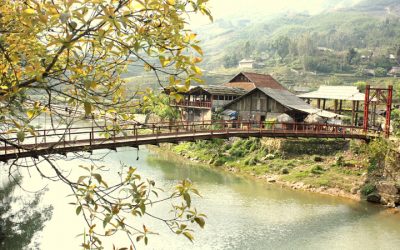Sapa travel blog – the ultimate guides and tips for travellers who want to experience truly Sapa highland town and surrounding: where to stay, what to do and where to eat.
Overview of Sapa
Sapa is a famous tourist destination in the north of Vietnam with majestic mountainous landscape and beautiful culture of ethnic minority people living in high mountains.
Tourists traveling to Sapa will have the opportunity to conquer the famous Fansipan peak or make a trip to the dusty villages hidden in the mist. Mountain scenery with hundreds of blooming flowers and clouds will certainly satisfy the visitors when they arrive here.
When to go Sapa
Sapa has an invaluable treasure that is a cool fresh climate, with a variety of nuances. Located at an average elevation of 1,500 m – 1,800 m, Sapa climate is quite the same as temperate countries, with an average temperature of 15 – 18 ° C. From May to August, Sapa has a lot of rain. At the end of the year, when the winter comes, the temperature in Sapa can drop to below 0 degrees, sometimes snow falls.
- The best time to travel to Sapa is from September to November or from March to May. This time Sapa weather is stable, dry in days, cold in nights.
- April – May, when ethnic minorities transplant rice on terraced fields. And this is also the bloom season of many beautiful flowers. The rice field is very beautiful, so photographers would like to go this season and rice season to get their best shots.
- September to October is the season of ripe rice, then all corners of Sapa are bright yellow. Around this time, Sapa seemed to wear new clothes covering all the hills with yellow. But you should go in the middle or late September, to October many places have been harvested.
- December to February, Sapa is very cold, can have ice and occasionally snow. This is also the bloom season of peach blossom.
Type of transportation to Sapa
From Hanoi to Sapa town

Greenbus Hanoi Sapa route

Eco Sapa Limousine

Orient express train Sapa
-
Hanoi to Sapa By Bus
Since the Ha Noi – Lao Cai expressway has been put into operation, the time for moving from Hanoi to Sapa by bus is only 5 hours – compared to 7 hours traveling by train. Moreover, traveling by bus, you could go straight to Sapa town, not having to stop at stop point Lao Cai as the trains do. The buses run many trips during the day, departing from Hanoi at 6 am, 2 pm and 10 pm. However, traveling by bus can be a problem in the rainy season.
On the Sapa – Hanoi route there are two options: Sleeper bus (fare starts from $ 10) and 9-Seat Luxury Limousine D-Car (fare starts from $ 19). You may take the night bus, departing from Hanoi at 10 pm to save one night staying at the hotel. However, the opportunity to enjoy the view of the mountains through the window would be missed.
Find more about choosing the most suitable bus from Hanoi to Sapa
-
Hanoi to Sapa By Train
There are many kinds of train, such as normal trains, air-conditioned sleeper trains, etc. Hanoi Sapa trains run at 9 or 10 pm to Lao Cai early in the next morning. From Lao Cai to Sapa you could catch a shuttle bus at the cost of about $ 2 to Sapa. These vehicles are at the train station gate.
Victoria express train Sapa
Exploring Sapa and surrounding
-
Motor rental

Motorbike rental in Sapa
Motorbike rental in Sapa would cost about 120,000 – 180,000 VND per vehicle, excluding petrol to drive to visit places. Please be noted that in Sapa, the rental fee will be charged in one day (6 am to 6 pm), so renting in the afternoon will be charged the same price as renting in the morning. Rentee must return the bikes at 6:00 pm or 8:00 pm at the latest
-
Biking
-
Taxi
-
Car rental
Sapa to other destinations
- Sapa to Halong: Sleeping bus directly run 4 times daily between Sapa and Halong that cost about $22/tickets. Sapa Halong bus pick up and drop off you at the station in Sapa and Halong (Bai Chay), it take about 8 hours to transfer.
- Sapa to Cat Ba:
- Sapa to Luangphabang
- Sapa to Bac Ha
- Sapa to Ha Giang
Eating in Sapa
For eating meals and breakfast you can go to the food market near the square, opposite the church which has a wide variety of food and detailed prices listed on the menu. The restaurants on Sapa have public menus on the outside so it is very convenient for you to choose. Street foods are also available.

Local cuisine in Sapa
To learn more about the cuisine of Sapa and some fine restaurants, see the Sapa food.
Attractions nearby Sapa
-
Cat Cat Village

Cat Cat village – Sapa
Cat Cat is a traditional Mong village, where traditional handicrafts such as cotton, linen, and weaving are still preserved. The site has now been built into a Cat Cat village tourist site.
-
Sapa Stone Church
Sapa stone church built in 1895 is considered to be one of the oldest architectures left by the French. The church has been preserved, becoming an indispensable image when referring to the misty Sapa town.
-
Ham Rong mountain
Standing on the top of Ham Rong Mountain, you can enjoy the panoramic view of Sapa, Muong Hoa valley and Ta Phin hiding in the mist. On Ham Rong, visitors feel like the holy garden, with clouds surrounded human bodies and colorful flowers on the ground.
-
Sin Chai Village
Sin Chai village is in San Sa Ho ward, about 4km from the center of Sapa town. It is one of a few villages which have not been affected by “tourism” so still retains the original wild. This is a Black Mong village with the population of about 1400 people. In addition to planting rice and corn, Sin Chai people also choose gentle mountain ridges to grow cardamom which brings a significant source of income for the ancient valley.
-
Ta Van village

Tavan village – Sapa
Follow national road 4D to the southeast, about 8 km from Sapa town, you would find yourselves in Ta Van Giay village. Here, visitors would have the opportunity to learn more about the culture and lifestyle of the Giay people. The road to Ta Van Giay village is small, narrow and dirt. The fertile terraced fields on the two sides of the road are decorated with green corn and green rice.
-
Ta Phin village
This place has beautiful natural scenery, cultural characteristics of the Red Dao people who are very famous for their beautiful brocade. At Ta Phin village, you can visit the nearby Ta Phin Cave. In the cave, there are many interesting stalactites with the shapes of dancing people, sitting elves, distant fields, sparkling forest.
Some far away Sapa destinations
-
Fansipan mountain – the rooftop of Indochina
Fansipan is the highest mountain, namely the rooftop of the Indochinese Peninsula with the height of 3143 m, located in the heart of Hoang Lien Son Range. The trekking journey to its top usually takes about 2 days 1 night. The first night, you will rest at Tram Ton (about 2,000 meters high above the sea level). On the way to the top of the Fansipan mountain, visitors will discover the interesting fauna and flora and the beauty of mother nature.
Or you can choose cable car. Fansipan cable car went into operation in early 2016, has helped tens of thousands of visitors set foot to Fansipan peak to admire, discover, conquer the highest rooftop of Indochina. The time to admire Fansipan peak has been shortened from 2 days to only 15 minutes.
Location: 9 km to the southwest of Sapa town.
-
Hoang A Tuong Mansion
The architectural style Hoang A Tuong mansion is the combination of Asian and European style, creating harmony, rectangular layout. This is a beautiful architecture illustrating the beauty of highlands.
Location: center of Bac Ha district, Lao Cai.
-
Bac Ha market

Colorful Bac Ha market
Bac Ha is the largest trading market in the highland border area. The market is organized on a weekly basis, attracting crowds around the area to trade and play. This is still the place for ethnic minorities, mainly ethnic people from around the villages to exchange, buy and sell lots of things. The booths present all the essential items such as clothes, shovels and, furniture.
Location: center of Bac Ha town, 60km from Lao Cai city.
The experience you should try when traveling to Sapa
-
Climbing Fansipan Moutain
Conquering the roof of Indochina is the dream of many young people. If you like to challenge and break your limits, then do not hesitate to go.
-
Witnessing the world’s most amazing terraces
The terraces in Sapa are honored to be one of the most magnificent terraces in the world. September is the time of harvest, the green fields are gradually replaced by yellow one. This is a very attractive time to visit Sapa.
-
Climbing Ham Rong, enjoying panoramic view of Sapa town
Observing the town from the hight of 1800 m on Ham Rong Mountain is an enjoyable experience that anyone visiting Sapa should try. In a different perspective, the roads, hotels, tourist resorts are tiny. Not only that, on Ham Rong Mountain you can admire the flower garden full of color and go through the small rocky ravines in Thach Lam Rock Garden
-
Enjoying Dawn and sunset in Sapa
The early morning winds will make you shiver slightly. Hold on to the warm coffee cup, tasting the omelet dish next to it, looking out the window from a beautiful hotel, you will witness a gentle Sapa in the early morning mist. Wait until the afternoon, the sun disappears behind the Hoang Lien Son range, Sapa is dyed by purple.
-
Homestay in the house of Ethnic Minority

Homestay in Lao Chai Ta Van village
Arrive Sapa, sleep in the house of an ethnic minority. Eat traditional, refreshing food, waking up in the village far from the town center will be a wonderful experience that you cannot forget as you come to this land. The homestay service in Sapa is highly developed, you can be assured about the hygiene of housing and the quality of the food.
-
Admiring the Majestic view at O Quy Ho Pass
Along the way to Lai Chau, across the Silver Falls and Love Waterfall, you will visit the peak of O Qui Ho Pass which is one of the four great mountain passes in the North of Vietnam. Standing on the top of the pass, you will see the routes connecting the two provinces of Lao Cai and Lai Chau. Next to it is the Hoang Lien Son range.
Hotels and Homestay in Sapa
See details on hotels and hostels in Sapa.
If you need any further information about Sapa, please do not hesitate to contact us.

















